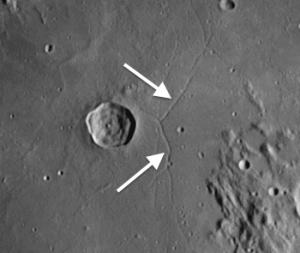 The week of November 4-10 takes us from the end of Day 7 to Day 13. This week we will highlight the Triesnecker rilles, viewable on Monday evening.
The week of November 4-10 takes us from the end of Day 7 to Day 13. This week we will highlight the Triesnecker rilles, viewable on Monday evening.
Triesnecker rilles: [NE/J10] What a great place to poke around with your telescope! This is such a complex system of rilles that it looks like a railway switchyard! Which do you think came first, the crater or the rilles?1
The width of the rilles measures between one-half mile and one mile. The largest rilles can be seen in a three-inch refractor, but the whole system requires larger apertures and good seeing. There are at least nine rilles crisscrossing each other. Make a sketch of how many you can see, then come back later and try to improve on it.
 Scientists are not sure how the Triesnecker rilles developed. Their origin still remains a mystery, but the consensus is they are not grabens, as the Ariadaeus rille is [NE/J11]. Enjoy them as one of the Moon’s many enigmas.
Scientists are not sure how the Triesnecker rilles developed. Their origin still remains a mystery, but the consensus is they are not grabens, as the Ariadaeus rille is [NE/J11]. Enjoy them as one of the Moon’s many enigmas.
OF ADDITIONAL INTEREST IN SPACE THE WEEK OF NOVEMBER 4-10:
On Monday morning, November 11, there will be a comparatively rare event: Mercury will transit across the face of the Sun and will be visible from all parts of the U.S. The transit will be in progress as the Sun rises and will last until 11:00 a.m. You will need access to a telescope with a solar filter. The tiny black dot of Mercury cannot be seen without magnification, so your solar glasses alone won’t work. Do not, under any circumstances, look through a telescope with just your solar eclipse glasses. The heat buildup will burn through the material and cause serious damage to your eyes. For more specific transit times go to: https://www.timeanddate.com/eclipse/transit/2019-november-11
1There is a rille approaching Triesnecker’s northeast rim that looks like it has been interrupted by the crater, suggesting that the rilles were there first.
======================
It is highly recommended that you get a copy of Sky and Telescope’s Field Map of the Moon, the very finest Moon map available for use at the telescope. It is available for $10.95 at www.skyandtelescope.com and on Amazon. All features mentioned in this blog will be keyed to the grid on the Field Map and will look like this: Plato: [NW/D9]
Credits:
Courtesy of Gray Photography of Corpus Christi, Texas
Lunar photos: NASA / USGS / BMDO / LROC / ASU / DLR / LOLA / Moon Globe. Used by permission
- Rupes Cauchy: A Best Known Fault on the Moon - July 22, 2024
- Moon Crater Schickard – Crater Floor has Stripes - July 15, 2024
- Moon Craters Langrenus and Vandelinus - July 8, 2024